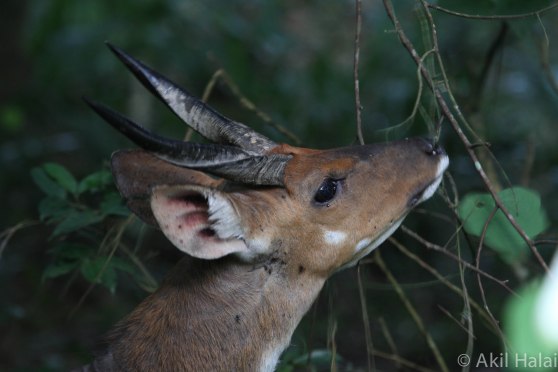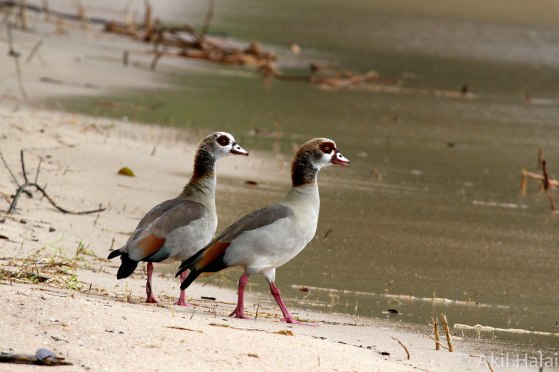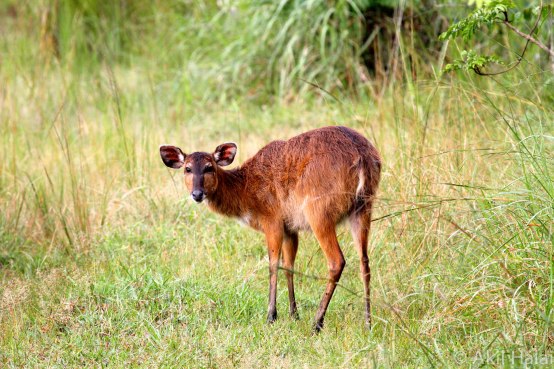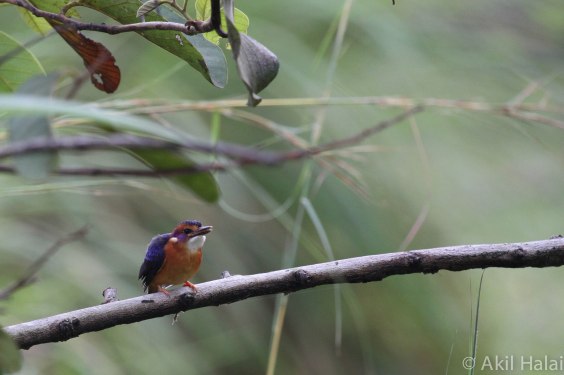Blog
June 26, 2014
Rubondo Island – Lake Victoria – Treasure Island
By Akil Halai, Field Operations Coordinator, Asilia Tanzania
Tanzanian-born bird enthusiast Akil Halai recently visited Rubondo Island on his eternal quest to the far-flung depths of East Africa to seek out and observe as many avian species as he can. Here he shares his experiences with us.
God has kept this secret sanctuary only for special people. From the landing to takeoff everything about this unique place is mystical—landing on the grass runway to a champagne welcome is stylish to say the least!
A deep forest covers most of the park, which also provides a diversity of wildlife habitats ranging from savannah, open woodland, swamps and dense forest. These habitats are home to various wildlife species such as sitatunga (also endemic to the Gombe ecosystem), bushbuck, vervet monkeys, genet cats, spotted necked otters, hippos and crocodiles which share ecological niches with introduced species such as chimpanzee, elephant, giraffe, black & white colobus monkeys, suni and African grey parrots. During the summer, the island hosts a variety of migratory birds from different parts of the planet, making it truly a birder’s paradise.
The chimps are yet to be habituated to humans. Between 1966 and 1969, seventeen chimpanzees that had been captured in the wild and kept in European zoos and circuses were released on Rubondo with the help of Dr. Grizcmek and the Frankfurt Zoological Society. Now there is an estimated population of about 30 chimpanzees roaming the 60,000-acre island sanctuary. Rubondo is currently the only instance of domesticated chimpanzees being released back into the wild without any former rehabilitation successfully.
Asilia are helping out with the enormous task of getting the chimpanzees habituated to humans with generous donations to Tanzania National Parks (TANAPA), as well as supporting researchers to collect data on nesting and feeding habits and to observe their behaviour. TANAPA are in the preliminary stages of this project, which is expected to take a considerable length of time before results are achieved.
The Rubondo Island Lodge is meticulously camouflaged to integrate with the habitat. It has all you could possibly want. From friendly staff, good food and excellent accommodation. There are also plenty of activities to choose from—sport fishing for huge Nile Perch and Nile Tilapia (catch and release only), walking trails and hikes, guided game drives, boating safaris, canoe safaris, bird-watching, forest walks, chimp trekking or relaxing by the lake. Henk and Janine are highly experienced lodge managers and wonderful company to be with. Henk with his sport fishing expertise and Janine with her broad wildlife knowledge will keep you informed and entertained throughout your time at Rubondo Island Lodge. There is so much to see here. Days will fly by without realising its time to leave. After wonderful bird sightings & walks assisted by Habibu, our very knowledgeable guide and fellow bird-watcher, it wasn’t easy to bid farewell to this small and unspoilt paradise.
I will surely be back.
Many bushbuck are found on the island. Tending to be nocturnal near human habitations, this particular one was spotted at the lodge during the day and didn’t shy at all in front of the camera.
This paradise island has no rivers and the soil is volcanic. The habitat is mixed evergreen and semi deciduous forest, which covers about 80% of the island’s surface area with common species including Croton sylvaticus, Drypetes gerrardii, and Lecaniodiscus fraxinifolius.
Egyptian geese were considered sacred by the ancient Egyptians, and appeared in much of their artwork. They have been raised for food and extensively bred in parts of Africa since the ancient Egyptians domesticated them. This pair was however very much in the wild, enjoying some romance in the rain.
The Yellow-billed kite is an intra-African breeding migrant, visiting Rubondo Island from July–March and sometimes as late as May. It is generally common.
The rare sitatunga antelope lives in thickly vegetated, muddy swamps and marshes, where its long and widely-splayed hooves aid it in moving easily. Sitatungas are found in fair numbers on Rubondo. The only other place they can be found in Tanzania is in the Selous Game Reserve, and then only rarely.
You might miss spotting this very small kingfisher if you miss its “tsip-tsip” call in flight. This particularly unobtrusive “African pygmy kingfisher” was busy hunting for small insects while we were admiring it.
![]()











































Add comment
By Akil Halai, Field Operations Coordinator, Asilia Tanzania
Tanzanian-born bird enthusiast Akil Halai recently visited Rubondo Island on his eternal quest to the far-flung depths of East Africa to seek out and observe as many avian species as he can. Here he shares his experiences with us.
God has kept this secret sanctuary only for special people. From the landing to takeoff everything about this unique place is mystical—landing on the grass runway to a champagne welcome is stylish to say the least!
A deep forest covers most of the park, which also provides a diversity of wildlife habitats ranging from savannah, open woodland, swamps and dense forest. These habitats are home to various wildlife species such as sitatunga (also endemic to the Gombe ecosystem), bushbuck, vervet monkeys, genet cats, spotted necked otters, hippos and crocodiles which share ecological niches with introduced species such as chimpanzee, elephant, giraffe, black & white colobus monkeys, suni and African grey parrots. During the summer, the island hosts a variety of migratory birds from different parts of the planet, making it truly a birder’s paradise.
The chimps are yet to be habituated to humans. Between 1966 and 1969, seventeen chimpanzees that had been captured in the wild and kept in European zoos and circuses were released on Rubondo with the help of Dr. Grizcmek and the Frankfurt Zoological Society. Now there is an estimated population of about 30 chimpanzees roaming the 60,000-acre island sanctuary. Rubondo is currently the only instance of domesticated chimpanzees being released back into the wild without any former rehabilitation successfully.
Asilia are helping out with the enormous task of getting the chimpanzees habituated to humans with generous donations to Tanzania National Parks (TANAPA), as well as supporting researchers to collect data on nesting and feeding habits and to observe their behaviour. TANAPA are in the preliminary stages of this project, which is expected to take a considerable length of time before results are achieved.
The Rubondo Island Lodge is meticulously camouflaged to integrate with the habitat. It has all you could possibly want. From friendly staff, good food and excellent accommodation. There are also plenty of activities to choose from—sport fishing for huge Nile Perch and Nile Tilapia (catch and release only), walking trails and hikes, guided game drives, boating safaris, canoe safaris, bird-watching, forest walks, chimp trekking or relaxing by the lake. Henk and Janine are highly experienced lodge managers and wonderful company to be with. Henk with his sport fishing expertise and Janine with her broad wildlife knowledge will keep you informed and entertained throughout your time at Rubondo Island Lodge. There is so much to see here. Days will fly by without realising its time to leave. After wonderful bird sightings & walks assisted by Habibu, our very knowledgeable guide and fellow bird-watcher, it wasn’t easy to bid farewell to this small and unspoilt paradise.
I will surely be back.
Many bushbuck are found on the island. Tending to be nocturnal near human habitations, this particular one was spotted at the lodge during the day and didn’t shy at all in front of the camera.
This paradise island has no rivers and the soil is volcanic. The habitat is mixed evergreen and semi deciduous forest, which covers about 80% of the island’s surface area with common species including Croton sylvaticus, Drypetes gerrardii, and Lecaniodiscus fraxinifolius.
Egyptian geese were considered sacred by the ancient Egyptians, and appeared in much of their artwork. They have been raised for food and extensively bred in parts of Africa since the ancient Egyptians domesticated them. This pair was however very much in the wild, enjoying some romance in the rain.
The Yellow-billed kite is an intra-African breeding migrant, visiting Rubondo Island from July–March and sometimes as late as May. It is generally common.
The rare sitatunga antelope lives in thickly vegetated, muddy swamps and marshes, where its long and widely-splayed hooves aid it in moving easily. Sitatungas are found in fair numbers on Rubondo. The only other place they can be found in Tanzania is in the Selous Game Reserve, and then only rarely.
You might miss spotting this very small kingfisher if you miss its “tsip-tsip” call in flight. This particularly unobtrusive “African pygmy kingfisher” was busy hunting for small insects while we were admiring it.